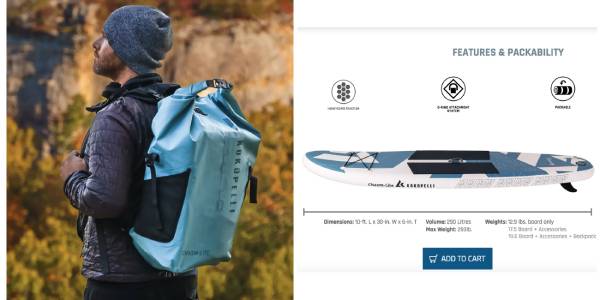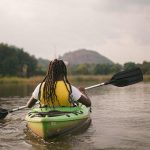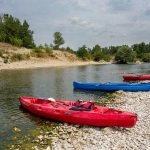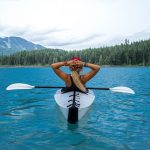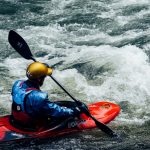The most common factor of whitewater fatalities in the Rockies is cold water, according to a recent Outside Online article.
The lesson to be learned from this is that cold water can be deadly. 61% of fatalities in the Rockies are caused by this.
What can we do to keep ourselves safe on our waterways, considering that all environmental factors are fixed?
This study suggests that we invest in better equipment and training.
This made us at CKS Online think that the most important piece of gear may not be your throw bag, wrap kit, repair supplies, or cooler full of beer (or sparkling water), instead it could be your chosen clothing for that day’s adventure.
Here are some tips and considerations for deciding what to wear when you venture out
Factors that determine what to wear:
- Water Temperature
- Weather
- Activity/Activity Level
- Every “body” is different
Water Temperature
The most important factor to consider when choosing what to wear for the day is the temperature of the water.
Water conducts heat away from the body significantly more efficiently than air does, making it a much more significant factor. coldwater is defined as water that is below 70 degrees Fahrenheit, according to the mentioned studies.
This means that nearly all bodies of water in Colorado are classified as cold. Your “baseline” clothing for the day will be determined by the water temperature. Any other conditions (such as weather or level of activity) will let you add or remove thermal clothing to adjust your temperature and deviate from your average.
For example, if the water temperature is 55 degrees, I would wear some splash gear and some insulation. However, as the weather is warm at 80 degrees and there is little chance of swimming or getting extremely wet, I reduce the amount of gear I take with me.
Here’s an example of what to wear when the water is a little warmer at 75 degrees: boardshorts and a rashguard. Even though it’s not my intention, I often end up falling into the water while stand-up paddleboarding on a particular section of river. It is 75 degrees outside and partly cloudy. Adding neoprene will help regulate my body temperature in the water or when the sun is not out.
Weather
Weather is the second most important factor to consider when layering clothing.
Although spring weather is usually unpredictable, it can be especiallyset in the Rocky Mountains.
Choosing your clothing options for an excursion assuming the weather will be the same throughout is the most common mistake.
This is something that has happened to me a lot over the years as a full-time whitewater guide. At this time of year, it is not unusual for the weather in the Rocky Mountains to be cloudy and cooler, with occasional rain showers.
guides would tell guests they didn’t need extra layers because it was warm and sunny The clouds and rain were getting closer as we kept moving!
Make sure you are prepared for the weather conditions that are forecasted, but also have extra clothes in case you need them.
Activity / Activity Level
Not all water activities are the same, so your clothing choices should be different too. This means that if you are more likely to get wet and stay wet, you should wear warmer clothing.
Rowing a raft in class I water is a calmer activity than surfing on a high volume river wave. Although the water temperature is the same, the activity makes a big difference.
As a member of the US Men’s Raft Team, I will wear different clothing for a scouting/training run vs an actual race. During a scouting run, you don’t need to worry as much about overheating since you’ll be active for a shorter amount of time. However, during a race scenario, you need to be more careful about what you wear so you don’t get too hot.
Every “Body” is Different
Whether you’re getting dressed for work or for a night out, one of the least discussed factors in deciding what to wear is the weather. Nevertheless, one to take into consideration is individuality.
There is a lot of variation in the levels of body fat and cold tolerance among people.
Just because someone else is wearing board shorts and “skin to win” under their life jacket does not mean you should too. We each have to make our own decisions about what clothing to choose, based on the factors mentioned above. We have to live with the consequences of our choices.
Types of Layers
Now that we know what will influence our decisions on what to wear, let’s talk about what our clothing options are and how to use them.
WETSUIT
Wetsuits are a type of clothing that has been around for a long time and is designed to keep the water next to your skin warm using your own body heat and the thick neoprene material. The thickness of neoprene is typically measured in millimeters. The thicker the millimeter, the warmer the suit.
New wetsuit technologies, like NRS’s Hydroskin line, have incorporated heat-reflecting titanium and cozy fleece-like linings to improve the efficacy of the neoprene while reducing the overall thickness. To learn more about why CKS Online believes that Hydroskin is the best possible wet suit choice, please visit their website.
If you will be coming in contact with water a lot, it is best to use a wetsuit. If you’re not in the water, your wetsuit won’t work as well and you’ll be more susceptible to wind and weather damage.
Layering
Before we dive into the specifics of kayak clothing, we should discuss the concept of layering. Wearing different layers of clothing to manage body temperature is called layering. You can add or remove garments to make sure you’re comfortable. Typical layers include a base layer, insulation and shell.
Wearing a base layer next to your skin helps to keep you drier and more comfortable by managing moisture. Insulation is worn over base layers for warmth. Shells are garments that are worn over other clothing to protect from the elements, typically wind and rain.
The way you layer your clothing for kayaking is different than how you would layer for other outdoor activities, but the idea of layering is still important for understanding how to dress comfortably and safely while on the water.
Base Layers
A base layer is a piece of clothing that is worn next to the skin in order to manage perspiration by wicking moisture. Base layers help to regulate your body temperature by wicking moisture away from your skin and into the fabric.
The fabric then pulls the moisture away from your body and out to the atmosphere, helping you to stay cool and dry. Most wicking base layers are made from polyester. It doesn’t absorb water and dries quickly. Merino wool is also used as a base layer.
Merino may not dry as quickly as polyester, but it is still a very effective material. It is warm when wet, wicks away moisture effectively, and is also odor-resistant.
Nylon fabric is not often used in wicking base layers because it absorbs water and takes a long time to dry. This means that nylon is not a good choice to use for a layer of insulation. Nylon is a good choice for sun and heat protection because it dries slowly. It is often found in specialized hot weather clothing.
Base layers designed specifically for kayaking are sewn differently than those intended for hiking or mountaineering.
Some features that are common in athleisure wear are seams being moved away from the underarm area to reduce chafing, waistbands being cut higher to prevent gapping while seated, and longer hems in tops.
Insulating Layers
Insulation for kayaking comes in two types: wet and dry. As mentioned before, wet insulation is meant to keep a person warm even when they’re wet. Dry insulation is normally worn under a drysuit, but it can be put on in layers with a wetsuit.
There are two types of insulation – dry and wet. Dry insulation is more versatile and can be used for a variety of outdoor activities. Wetsuits are typically only used for paddling and cold water protection.
Wetsuit layers are made of neoprene or similar materials. The warmer the wetsuit, the better it will insulate. Neoprene that is thinner is more flexible, which makes paddling less restrictive.
This is because thicker wetsuits are more restrictive and many of the warmest wetsuits are made without sleeves. These sleeveless, one-piece wetsuits from Farmer John (or Farmer Jane) offer plenty of insulation for the legs and torso, and more flexibility in the arms and shoulders.
Shell Layers
The outer shell of a paddler’s clothing helps to keep them dry and protected from the wind. Both wet and dry clothing systems require shell layers. Wetsuits alone will not protect you from the wind, you will need to wear a shell over your wetsuit to prevent your body heat from evaporating.
Fleece insulation will keep you warmest when it is dry, so make sure to wear it under a drysuit.
There are usually three layers to a kayaking shell: an outer layer that is waterproof and has sealed seams to prevent leaks, a middle layer for insulation, and an inner layer that is made of a material that will not absorb water.
The most versatile shell layers are made from materials that allow airflow. The materials allow some sweat to escape from the inside of the fabric. This makes it so you don’t get as wet and are more comfortable while paddling.
Breathable fabrics can’t always handle a lot of sweat during strenuous exercise, but they don’t feel as sweaty as non-breathable coated fabrics. The ones that are the best fit more comfortably.
Kayaks have specialized neck, wrist, and ankle closures to help keep water out. Conventional closures cannot seal sleeves and ankles as tightly as neoprene or similar cuffs can. Latex gaskets are even drier than the drysuits and drytops.
The gaskets are made of rubber and are flexible so they fit snugly around your wrists and neck to prevent water from entering the suit. While some people may find the tight fit constricting, others may prefer less watertight closures that can be adjusted for comfort.
What Shoes To Wear Kayaking
There are two main types of shoes for kayaking: neoprene footwear and water shoes. Sandals are also worth a mention.
Neoprene footwear can include everything from thin wetsuit socks to waterproof boots. Neoprene footwear is advantageous because it is flexible and warm. Neoprene keeps you warm even when wet, and most neoprene booties have a thin sole that can easily fit into the cockpits of smaller kayaks.
Waterproof neoprene boots are the driest and warmest option. Neoprene booties or socks that are thin and flexible are more comfortable in warm weather.
Water shoes typically have less insulation than neoprene footwear, but they often have more support. Water shoes that offer the most minimal coverage are slip-on shoes with a thin sole to protect your feet from sharp objects.
There are sturdier shoes available that have thicker soles for more support and cushioning when walking on land. The best options for support have laces that go up above the ankle. Most water shoes have soles that grip well to prevent slipping on rocks.
Some common features of these shoes are water drains, supportive uppers and low-profile heels. If you’re going to be in cold water, you can wear water shoes with neoprene socks to keep your feet warm.
Some kayakers prefer to wear water sandals in warm weather conditions. Sandals are not the best choice of footwear for kayakers as they can be quite uncomfortable.
Some kayakers may have difficulty fitting water sandals into their kayaks because the soles are typically bulkier than water shoes. Since sandals don’t have any padding on the heel, they can’t protect a person’s feet from pressure and abrasion.
Extra Layers
Kayakers should take extra layers of clothes with them when they go out for a day on the water. The extra layers you’ll need will depend on the location and conditions of your paddling trip. Even a hot day can turn windy.
Waves and spray can create an unexpected chill. Wearing different insulating or base layers in colder weather or on multi-day tours can improve your comfort and safety. In bad weather, it is a good idea to wear an extra shell layer over your clothes.
Wearing extra layers is a good idea no matter what the weather is like. Make sure to pack your items in a waterproof drybag so they will be dry in case you need them.
